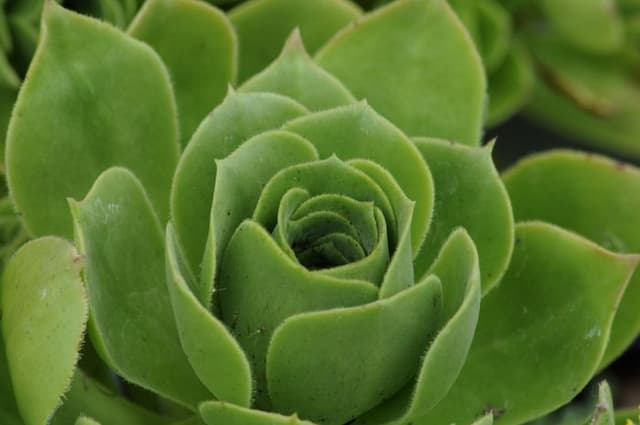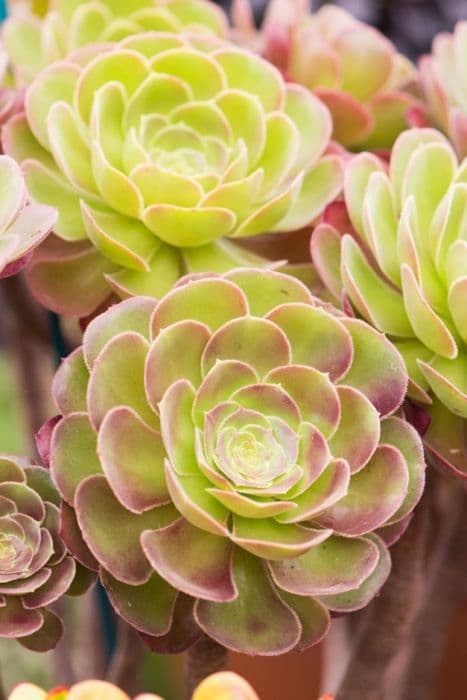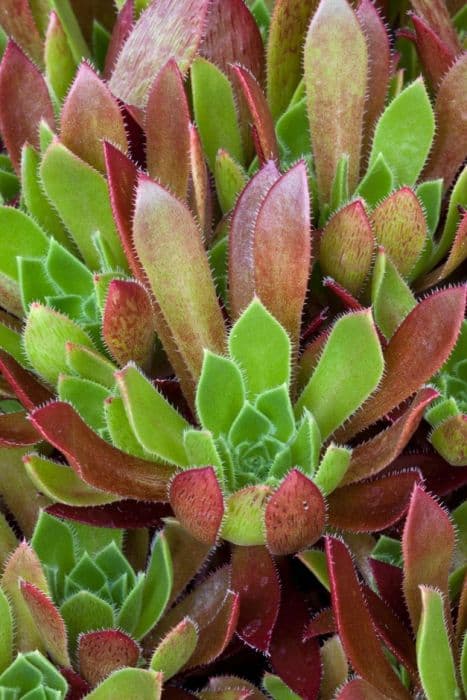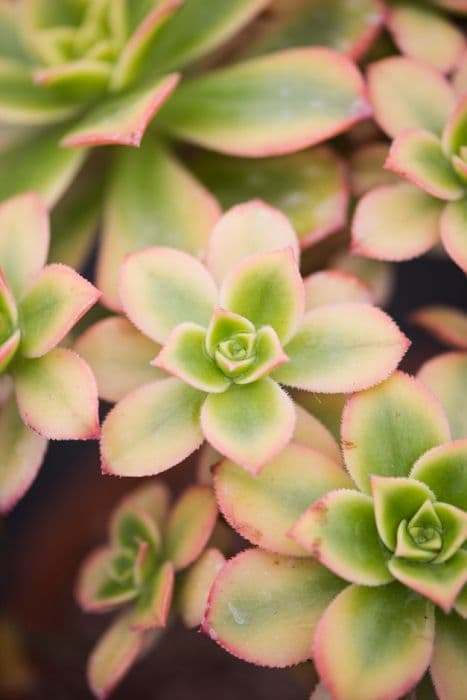Goldmoss Stonecrop Sedum acre 'Golden Queen'

ABOUT
Sedum acre 'Golden Queen', often called Goldmoss Stonecrop, boasts striking features that easily catch the eye in garden landscapes. This succulent plant is characterized by its vivid, lime- to golden-yellow leaves. Its foliage forms a dense, mat-like ground cover, with leaves that are small, fleshy, and tightly packed together. The leaves have a slightly rounded, almost jelly-bean-like shape, with a glossy texture that can appear almost translucent, especially when backlit by the sun. During the blooming period, Goldmoss Stonecrop becomes even more enchanting when it becomes adorned with clusters of tiny, vibrant yellow, star-shaped flowers. These blooms add bursts of color and can be quite showy, giving the plant a cheerful and bright appearance. The contrast between the golden foliage and the yellow flowers, which together create a monochromatic display, is an eye-catching feature of this plant. Overall, Sedum acre 'Golden Queen' is celebrated for its colorful, evergreen foliage and its ability to add a blanket of radiant color to the garden, particularly in rock gardens, along borders, or as a part of ground cover plantings. Its texture, flower form, and color make it an attractive choice for gardeners looking to bring a splash of golden hues to their outdoor spaces.
About this plant
 Names
NamesFamily
Crassulaceae.
Synonyms
Goldmoss Stonecrop, Goldmoss Sedum, Biting Stonecrop, Wall Pepper, Golden Queen.
Common names
Sedum acre 'Golden Queen'
 Toxicity
ToxicityTo humans
The common name for Sedum acre 'Golden Queen' is Goldmoss Stonecrop. Goldmoss Stonecrop contains alkaloids along with other potentially toxic compounds. It is considered mildly toxic to humans. If ingested, the plant can cause gastrointestinal upset, including symptoms like nausea, vomiting, and diarrhea. In some people, the sap of the plant may also cause skin irritation or allergic reactions. It's important to handle this plant with care and to refrain from ingesting any part of it to prevent possible adverse health effects.
To pets
The common name for Sedum acre 'Golden Queen' is Goldmoss Stonecrop. Goldmoss Stonecrop is known to be toxic to pets, including both cats and dogs. The toxic components in this plant can lead to vomiting, diarrhea, and lethargy if ingested. In more severe cases, ingestion could cause increased salivation, weakness, or changes in heart rate. It's advisable to keep this plant out of reach of pets to ensure their safety. If you suspect your pet has ingested Goldmoss Stonecrop, you should seek veterinary attention promptly.
 Characteristics
CharacteristicsLife cycle
Perennials
Foliage type
Evergreen
Color of leaves
Golden
Flower color
Yellow
Height
4 inches (10 cm)
Spread
12 inches (30 cm)
Plant type
Succulent
Hardiness zones
5
Native area
Europe
Benefits
 General Benefits
General Benefits- Low Maintenance: Sedum acre 'Golden Queen' requires minimal care once established, making it ideal for gardeners of all levels.
- Drought Tolerant: This plant is highly resistant to drought, suitable for xeriscaping and water-wise gardens.
- Attractive Ground Cover: Its dense, mat-forming habit helps suppress weeds and covers bare spots effectively.
- Bright Foliage: The yellow-green leaves provide vibrant color and texture to garden landscapes throughout the growing season.
- Pollinator Friendly: The flowers attract bees, butterflies, and other pollinating insects, promoting biodiversity.
- Hardy Plant: It is resilient to cold temperatures, making it a good choice for gardens in cooler climates.
- Soil Erosion Control: The sturdy nature of the plant helps control soil erosion on slopes and other vulnerable areas.
- Easy to Propagate: It can be easily propagated through cuttings or division, making it a cost-effective choice for garden expansions.
 Medical Properties
Medical Properties- This plant is not used for medical purposes.
 Air-purifying Qualities
Air-purifying QualitiesThis plant is not specifically known for air purifying qualities.
 Other Uses
Other Uses- Sedum acre 'Golden Queen', commonly known as goldmoss stonecrop, can be used to create green roofs due to its hardiness and drought resistance, offering insulation and reducing urban heat islands.
- It serves as a living mulch in gardens, retaining soil moisture and suppressing weed growth while adding a splash of color with its bright yellow flowers.
- This plant can be utilized in fairy gardens or miniature landscapes because of its small size and ability to thrive in shallow soils.
- Goldmoss stonecrop is often included in xeriscaping designs to reduce the need for irrigation thanks to its drought-tolerant nature.
- The species can be planted in between paving stones or stepping stones to create a lush, green ground cover that can tolerate some foot traffic.
- Goldmoss stonecrop can function as a soil erosion control agent on slopes or banks due to its mat-forming habit and robust root system.
- This plant is a suitable choice for rock gardens, complementing the texture of the rocks with its succulent foliage and vibrant blooms.
- As a nectar source, it can attract beneficial pollinators like bees and butterflies to the garden, enhancing pollination of surrounding plants.
- Sedum acre 'Golden Queen' can be used in container gardening, either as the main plant or a spiller element, due to its low-maintenance nature and trailing growth.
- In craft projects, the leaves and flowers of goldmoss stonecrop can be used to create natural plant arrangements or as components in wreaths and floral designs.
Interesting Facts
 Feng Shui
Feng ShuiThe Goldmoss Stonecrop is not used in Feng Shui practice.
 Zodiac Sign Compitability
Zodiac Sign CompitabilityThe Goldmoss Stonecrop is not used in astrology practice.
 Plant Symbolism
Plant Symbolism- Resilience & Toughness: Sedum acre, commonly known as Goldmoss Stonecrop, has the ability to thrive in harsh, rocky environments, symbolizing the strength to persevere through challenging conditions.
- Prosperity & Abundance: The 'Golden Queen' variant, with its lush golden foliage, often represents wealth and the abundance of riches, much like the precious metal gold.
- Persistence: Goldmoss Stonecrop spreads quickly and can cover ground persistently, symbolizing the trait of persistence in one's endeavors.
- Adaptability: Sedum acre's capacity to adapt to various soil types and climates stands for flexibility and the ability to thrive in different situations in life.
- Longevity: This plant is long-living with minimal care required, symbolizing longevity and enduring presence.
 Water
WaterFor Goldmoss Sedum, water sparingly as it has drought-tolerant properties, typical of succulents. During the growing season, watering every 7-10 days with about 8-12 ounces per square foot is sufficient, allowing the soil to dry out between waterings. In winter, reduce watering to once a month or less as plant growth slows down. Overwatering can lead to root rot, so it's crucial to ensure good drainage and avoid standing water. It’s best to water the plant at the base, rather than from above, to minimize the risk of moisture on the leaves, which can cause fungal diseases.
 Light
LightGoldmoss Sedum thrives in full sun to partial shade conditions. It prefers to be located in a spot that receives at least 6 hours of direct sunlight daily, although it can tolerate some light shade, especially in hotter climates. Avoid placing it in deep shade, as this can lead to poor growth and less vibrant foliage.
 Temperature
TemperatureGoldmoss Sedum is hardy and adapts well to a range of temperatures. It can usually survive in temperatures as low as -30°F and as high as 90°F. However, the ideal temperature range for optimal growth is between 65°F and 75°F. It's important to protect the plant from extreme cold by providing mulch or bringing it indoors if it's in a container.
 Pruning
PruningPrune Goldmoss Sedum mainly to maintain its shape or remove dead foliage. Pruning is best done in early spring before new growth starts. Occasionally, after flowering, you may trim back the plants to promote a second bloom and prevent them from getting leggy. Sedums can be pruned every year or as needed to remove any damaged or diseased parts.
 Cleaning
CleaningAs needed
 Soil
SoilGolden Carpet Sedum thrives in well-draining, gritty soil with a pH between 6.0 and 7.5. A mix of one part potting soil, one part coarse sand, and a handful of pebbles or perlite ensures good drainage and aeration, which is crucial for healthy roots.
 Repotting
RepottingGolden Carpet Sedum does not require frequent repotting, as it is quite tolerant of crowded conditions. Generally, repotting every 2-3 years is adequate for this low-maintenance succulent, or when you notice the potting mixture has degraded or the plant has outgrown its container.
 Humidity & Misting
Humidity & MistingGolden Carpet Sedum prefers a dry environment and does well in average household humidity levels. It is tolerant of low humidity conditions, making it an ideal plant for dry climates and indoor settings with less humidity.
 Suitable locations
Suitable locationsIndoor
Keep in a sunny spot, water sparingly.
Outdoor
Plant in full sun, well-draining soil.
Hardiness zone
3-9 USDA
 Life cycle
Life cycleSedum acre 'Golden Queen', commonly known as Goldmoss Stonecrop, begins its life as a seed that germinates in spring when the soil temperature warms. The seedling emerges and develops into a vegetative plant with succulent leaves and a mat-forming habit. Throughout spring and into early summer, it enters the growth phase, rapidly expanding both in foliage and creeping stems. By mid to late summer, the plant reaches maturity and produces clusters of bright yellow, star-shaped flowers that attract pollinators. After flowering, seeds are set by late summer or early fall, which then disperse naturally or can be collected for propagation. In winter, the plant becomes dormant, though as an evergreen perennial, it maintains its foliage, ready to start the cycle again with the return of spring.
 Propogation
PropogationPropogation time
Spring-Early Summer
Propogation: The Stonecrop, specifically the variety known as 'Golden Queen', is best propagated during the spring or early summer when the plant is actively growing. The most popular method is through cuttings, which involves taking a piece from the plant's stem, leaf, or even a rosette. To propagate by cuttings, one will carefully remove a 2 to 4-inch section of stem (5 to 10 cm), ensuring there are leaves attached. The cut end should be allowed to callous for a few days to prevent rotting when planted. After the end has calloused, the cutting can be placed in well-draining soil, keeping it moist until roots have developed and it begins to show growth, which generally takes a few weeks. This straightforward method is favored for its ease and high success rate, allowing gardeners to quickly expand their Stonecrop collection or share cuttings with others.









